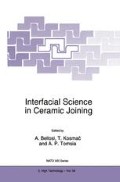Abstract
The maximum opening stress and minimum energy density criteria were adopted and modified in order to predict the path of a crack at the interface of two homogeneous, isotropic and elastic solids. The results obtained from the analytical (elastic) solution are compared with these from a FEM analysis (elastic-plastic case) but only for the maximum opening stress criterion. The elastic-plastic analysis revealed that crack advance along the interface is dictated from a combination of critical normal and shear stresses. Experimental data for the Si3N4)Fe/Si3N4 system support this result and indicate the limitation of the elastic solution. For the case of crack advance in one of the two adjacent materials, the comparison between analytical and numerical results has revealed similar values for the crack propagation angle. Comparison of the two criteria with experimental data taken from the Si3N4/Fe/Si3N4 system shows very good agreement between theory and experiment.
Work carried out within the Commission research and development programme.
Access this chapter
Tax calculation will be finalised at checkout
Purchases are for personal use only
Preview
Unable to display preview. Download preview PDF.
References
Evans, A.G., Rilhle, M., Dalgleish, B.J. and Charalambides, P.G. (1990) The Fracture Energy of Bimaterial Interfaces, Materials Science and Engineering, Al26, 53–64.
He, M.-Y. and Hutchinson, J.W. (1989) Kinking of a Crack out of an Interface, Transactions of the ASME, 56, 270–278.
He, M.-Y., Evans, A.G. and Hutchinson, J.W. (1991) Kinking of a Crack out of an Interface: Role of In-Plane Stress, Journal of the American Ceramic Society, 74 [4], 767–771.
Mukai,D.J., Ballarini, R. and Miller, G.R. (1990) Analysis of Branched Interface Cracks, J Appl. Mech., 57, 887–893.
Erdogan, F. and Sib, G.C. (1963) On the Crack Extension in Plates Under Plane Loading and Transverse Shear, J Bas. Engng., 85, 1–7.
Piva, A. and Viola, E. (1980) Biaxial Load Effects on a Crack Between Dissimilar Media, Eng. Fract. Meck, 13, 143–174.
Geubelle, P.H. and. Knauss, W.G. (1994) Crack Propagation at and Near Bimaterial Interfaces: Linear Analysis, ASME Journal of Applied Mechanics, 61, 560–566.
Sib, G.C. (1974) Strain-Energy-Density Factor Applied to Mixed Mode Crack Problems, Int. J of Fracture, 10, 305–321.
SiE, G.C. (1991) Mechanics of fracture initiation and propagation, Engineering Application of Fracture Mechanics, 11, Kluwer Academic Publishers, Dordrecht, NL, pp. 219–223.
Spyropoulos, C.P. and Ho, J.W. (1995) Prediction of Failure Initiating From Interface Crack in Dissimilar Media; in S.A. Paipetis and A.G. Youtsos (eds.), High Technology Composite in Modern Applications University of Patras, Applied Mechanics Laboratory, Patras, Greece, pp. 569–575.
Evans, A.G. and Hutchinson, J.W. (1989) Effects of Non-Planarity on the Mixed Mode Fracture Resistance of Bimaterial Interfaces, Acta metall, 37 [3], 909–916.
Hutchinson, J.W. and Suo, Z. (1990) Mixed Mode Cracking in Layered Materials, Advances in Applied Mechanics, 29, 64–191.
Rice, J.R. (1988) Elastic Fracture Mechanics Concepts for Interfacial Cracks, ASME J Appl. Mech., 55, 98–103.
Dundurs, J. (1969) Effect of Elastic Constants on Stress in a composite under plane deformation, Journal of Composite Materials, 1, 310–322.
Rice, J.R., Suo, Z. and Wang, J.-S. (1990) Mechanics and Thermodynamics of Brittle Interfacial Failure in Bimaterial Interfaces, in M. Ruhle, A.G. Evans, M.F. Ashby and J.P. Hirth (eds.), Metal-Ceramic Interfaces, Pergamon Press, NY, USA, pp. 269–294.
Stamos,V., Kostopoulos, V. and Peteves, S.D. (1997) Fracture Toughness Measurements of Bimaterial Interfaces, in K.-H. Schwalbe and M. Kogak (eds.), Mis-Matching of Interfaces and Welds. GKSS Research Center Publications, Geesthacht, FRG, pp. 295–306.
Stamos, V. (1996) Minimum energy density criterion for the interface crack, aÙ coefficients, unpublished results.
Stamos, V., Kostopoulos, V. and Peteves, S.D. (1996) Fracture Toughness Calibration of the Si3N4/Fe Joint System: A Parametric Study, Fatigue Fract. Engng Mater. Struct., 19 [4], 441–450.
O’Dowd, MP., Stout, M.G. and Shih, C.F. (1992):fracture Toughness of Alumina-Niobium Interfaces: Experiments and Analyses, Philosophical Magazine A,66 [6], 1037–1064.
Delale, F. and Erdogan, F. (1988) On the mechanical modeling of the interfacial region in bonded Half-planes, ASME Journal of Applied Mechanics, 55, 317–324.
Ritchie, R.O., Camion, RM., Dalgleish, B.J., Dauskardt, R.H. and McNaney, J.M. (1993) Mechanics and mechanisms of crack growth at or near ceramic-metal interfaces: interface engineering strategies for promoting toughness, Materials Science and Engineering B, B20 [1–2], 221–235.
Author information
Authors and Affiliations
Editor information
Editors and Affiliations
Rights and permissions
Copyright information
© 1998 Springer Science+Business Media Dordrecht
About this chapter
Cite this chapter
Stamos, V., Kostopoulos, V., Peteves, S.D. (1998). Fracture Criteria for Interface Cracks. A Case Study. In: Bellosi, A., Kosmač, T., Tomsia, A.P. (eds) Interfacial Science in Ceramic Joining. NATO ASI Series, vol 58. Springer, Dordrecht. https://doi.org/10.1007/978-94-017-1917-9_23
Download citation
DOI: https://doi.org/10.1007/978-94-017-1917-9_23
Publisher Name: Springer, Dordrecht
Print ISBN: 978-90-481-5086-1
Online ISBN: 978-94-017-1917-9
eBook Packages: Springer Book Archive

